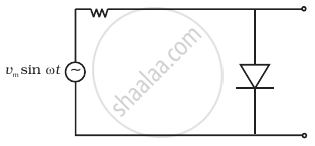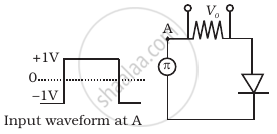Advertisements
Advertisements
Questions
Draw the circuit diagram of a half wave rectifier and explain its working.
Explain, with the help of a circuit diagram, the working of a p-n junction diode as a half-wave rectifier.
Solution
The circuit diagram for a half wave rectifier is shown below:

Working:
During the positive half cycle of the input a.c., the p-n junction is forward biased i.e the forward current flows from p to n and the diode offers a low resistance path to the current. Thus, we get output across-load i.e. a.c input will be obtained as d.c output.
During the negative half cycle of the input a.c., the p-n junction is reversed biased i.e the reverse current flows from n to p, the diode offers a high resistance path to the current. Thus, we get no output across-load. This principle is shown in the diagram given below.

APPEARS IN
RELATED QUESTIONS
Briefly explain how the output voltage/current is unidirectional.
In half-wave rectification, what is the output frequency if the input frequency is 50 Hz. What is the output frequency of a full-wave rectifier for the same input frequency.
When the diode shows saturated current, dynamic place resistance is _____________ .
Fill in the blank.
The ability of a junction diode to __________ an alternating voltage is based on the fact that it allows current to pass only when it is forward biased.
The device which uses centre-tapped secondary of the transformer is
A 220 V A.C. supply is connected between points A and B (figure). What will be the potential difference V across the capacitor?

The output of the given circuit in figure is given below.

Draw the output waveform across the resistor (Figure).
Give two differences between a half-wave rectifier and a full-wave rectifier.
With the help of a circuit diagram, explain how a full wave rectifier gives output rectified voltage corresponding to both halves of the input ac voltage.
